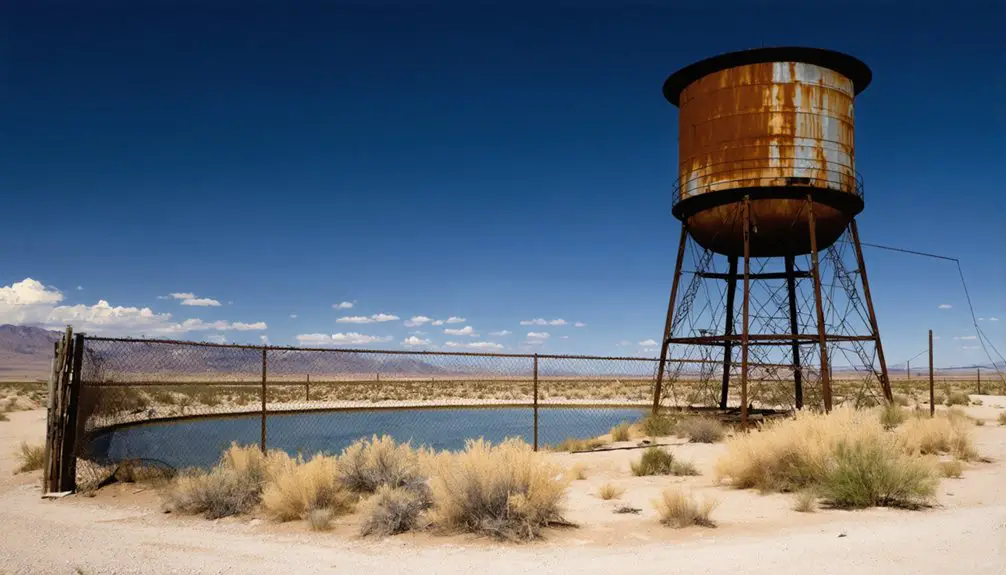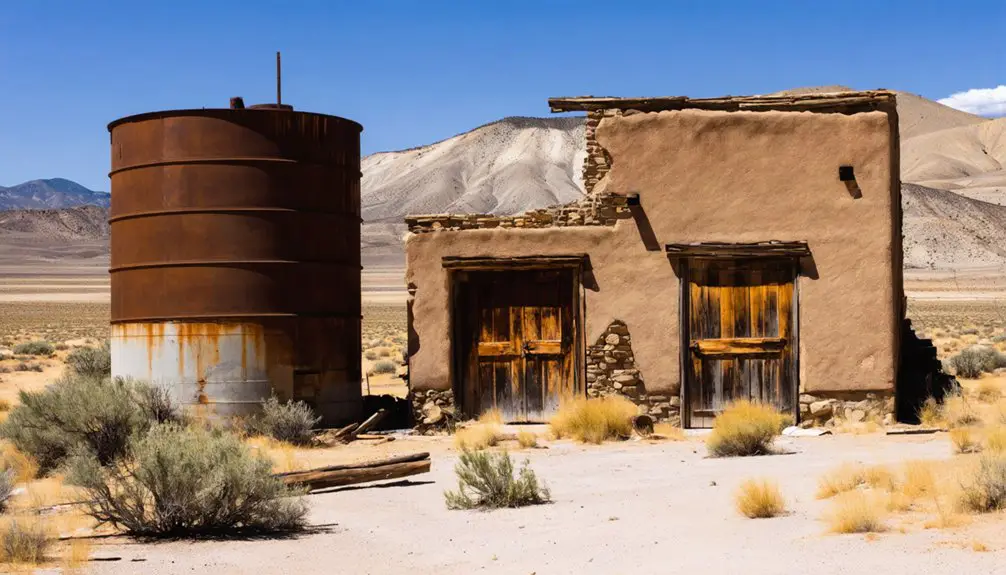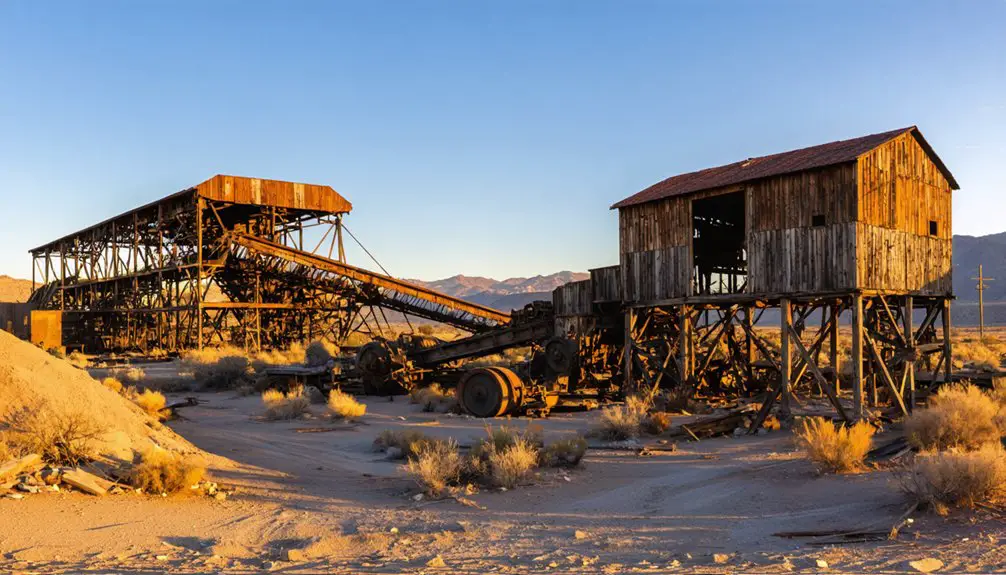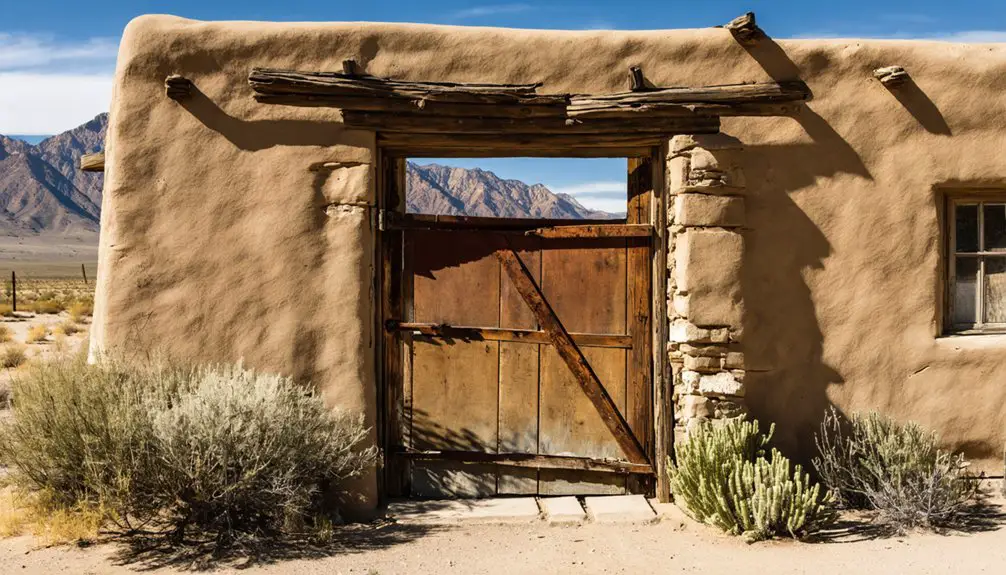You’ll discover Bullfrog, Nevada, a ghost town born during the state’s final gold rush in 1904. After Frank “Shorty” Harris and Ernest Cross struck gold yielding $700 per ton, the town quickly grew to 300 residents with hotels, saloons, and three railroad connections. Despite its promising start and the Montgomery-Shoshone mine’s $150,000 monthly output, Bullfrog’s glory faded by 1909. Today, weathered stone ruins and concrete foundations tell a fascinating tale of boom-and-bust mining history.
Key Takeaways
- Bullfrog, Nevada was a gold mining boomtown established in 1904 that flourished briefly before becoming a ghost town by 1909.
- The town reached its peak in 1905 with multiple businesses, railroads, and high-grade ore production worth $700 per ton.
- Water scarcity and competition from nearby Rhyolite led to population decline, with residents and businesses relocating to neighboring camps.
- The site’s remaining features include stone bank ruins, train station remnants, concrete sidewalks, and scattered foundations of historic buildings.
- Bullfrog’s decline was accelerated by the 1907 financial panic, with its post office closure in 1909 marking the end of formal services.
The Birth of a Mining Boomtown
Two chance prospectors, Frank “Shorty” Harris and Ernest L. Cross, forever changed Nevada’s ghost town history when they struck gold in the Bullfrog district on August 4, 1904.
Their discovery near Amargosa couldn’t have come at a better time, as Nevada was emerging from a 30-year economic slump. The exceptional ore quality, yielding $700 per ton, quickly attracted mining techniques that would define the era.
Nevada’s golden resurgence began as rich ore deposits yielding $700 per ton pulled the state from decades of economic hardship.
You’ll find that three settlements rapidly emerged: Amargosa, Bullfrog, and Bonanza, though they’d soon consolidate into a single Bullfrog townsite. The area’s rich mineral deposits included native silver found at multiple localities throughout the district.
By early 1905, you’d have seen a bustling community of 300 residents, complete with a hotel, jail, water system, and the Bullfrog Miner newspaper.
Even former Senator William Stewart joined the rush, signaling the district’s prominence in Nevada’s mining renaissance.
The district’s explosive growth led to the establishment of 165 mining companies by 1906, all seeking their share of the region’s mineral wealth.
From Amargosa to Bullfrog: A Town’s Evolution
As Bullfrog memories reveal, the town quickly grew to 300 residents and established essential infrastructure, including a hotel, jail, and water system.
In March 1905, the town underwent a significant change when Amargosa and Bonanza merged into a consolidated settlement.
The town reached its peak in 1905, featuring multiple thriving businesses that served the growing mining community.
The Bullfrog Miner newspaper began publication, and prominent figures like Senator William Stewart invested in permanent structures.
However, the town’s challenging water supply issues would soon lead many residents to seek better opportunities in nearby Rhyolite.
Life in Early Bullfrog
You’d find early life in Bullfrog centered around mining activities, with residents dealing daily with scarce water supplies that had to be expensively piped in and lumber that came at premium prices due to high transportation costs.
Despite these harsh conditions, the determined townspeople quickly established essential amenities including a hotel, jail, stores, saloons, and the “Bullfrog Miner” newspaper that began publishing in March 1905. The town’s fierce rivalry with nearby Armagosa led both settlements to offer settlers free barrels of water to attract new residents. The community maintained basic essential services including an icehouse and post office.
As the settlement grew, Senator William Stewart constructed a prominent ten-room adobe home and law office, while other community buildings like the bank and post office helped transform the former tent camp into a proper town.
Daily Mining Camp Life
Life in early Bullfrog demanded remarkable resilience from its inhabitants, who faced daily struggles against extreme temperatures reaching 130°F while working intensive mining shifts that plunged 250 to 300 feet underground.
You’d find yourself mucking and blasting through two grueling shifts, battling mining hazards in the desert’s punishing climate.
To survive, you’d seek shelter in dugouts or basic huts carved into mountainsides, relying on boarding houses for meals and rest.
Labor struggles led to the establishment of a union hall and hospital, offering some protection against the harsh realities of camp life.
You’d navigate a world where scrip currency replaced cash during shortages, and your success depended on adapting to ever-changing conditions as the mines’ fortunes rose and fell.
The discovery of high-grade surface ore in 1904 drew thousands of prospectors to the area, transforming the quiet desert into a bustling mining camp.
The town quickly grew from a tent village to accommodate nearly 1,000 residents seeking their fortunes in the desert.
Water Scarcity Challenges
Beyond the harsh mining conditions, Bullfrog’s most pressing challenge came from its extreme water scarcity. You’d find yourself paying premium prices for water delivered by barrel, as the waterless mining camp struggled with water conservation. Similar to the early Comstock camps, water was crucial for mining operations and daily survival. The region’s struggle mirrored the broader water allocation issues that would later shape the American West.
If you’d settled there in 1905, you’d have witnessed firsthand how the lack of reliable water infrastructure threatened mining sustainability and community growth.
While Bullfrog eventually established a basic piped system serving about 300 residents, it couldn’t match neighboring Rhyolite’s superior water development.
You’d have faced daily challenges in food preparation, hygiene, and mining operations, with water shortages affecting every aspect of camp life. Many settlers ultimately relocated to Rhyolite, where better water infrastructure promised greater stability, leading to Bullfrog’s gradual decline despite its mining potential.
Community Buildings Take Shape
Three essential structures anchored Bullfrog’s early transformation from a tent camp into a proper town in 1905: hotels, saloons, and the district’s first bank.
You’d find a remarkable display of community organization in the swift development of permanent buildings, including a $20,000 adobe complex built by former Nevada Senator William Stewart, complete with a 10-room home and law office.
The social dynamics of early Bullfrog centered around three hotels, three saloons, and a general store. A functioning jail maintained order, while The Bullfrog Miner newspaper, launched in March 1905, kept residents informed of local happenings.
The town’s infrastructure included a crucial water system, with discounted rates offered to encourage settlement in the water-scarce region.
Today, you can still spot the foundations of these once-bustling establishments.
Water Challenges and Infrastructure Development

As Bullfrog and nearby Amargosa struggled to establish themselves in Nevada’s harsh desert climate, water scarcity emerged as their most pressing challenge.
You’d find water sold by the barrel, often at discounted rates or given away free just to attract settlers to these parched outposts.
The Railroad Connection
You’ll find the bustling Bullfrog Goldfield Railroad‘s tracks once connected the town to major hubs like Goldfield and Beatty, with stations strategically placed to serve the mining district’s transportation needs.
The railroad’s arrival in 1907 transformed Bullfrog from an isolated camp into a connected mining center, enabling efficient ore shipment and bringing essential supplies to the growing community.
During World War II, most of the railroad’s metal infrastructure was salvaged for the war effort, leaving behind only traces of what was once a crucial transportation artery for the region.
Track Routes and Stations
During the early 1900s, three major railroads converged to serve the Bullfrog Mining District, creating an essential transportation network across southern Nevada.
You could travel seamlessly between Las Vegas, Ludlow, and various mining towns thanks to the cooperation between these rail lines at Bullfrog Junction. The strategic placement of stations and transfer points allowed for efficient movement of both passengers and freight across the desert landscape.
- The Bullfrog Goldfield Railroad stretched 85 miles, connecting Goldfield to the Bullfrog district
- Tonopah & Tidewater cooperation enabled travel from Ludlow to Gold Center and Beatty
- Key stations included Bullfrog (MP 170.18), Rhyolite (MP 171.58), and Goldfield (MP 242.69)
- Shared infrastructure at Bullfrog Junction (MP 241.59) allowed transfers between multiple rail lines
Rail Impact on Development
The arrival of railroads in the Bullfrog Mining District sparked a dramatic transformation of Nevada’s southern mining region.
As railroad innovations replaced slow-moving mule wagons, you’d find massive quantities of gold ore moving efficiently from remote camps to processing mills and broader markets.
The B&G Railroad’s completion in 1907 ignited fierce economic competition with the Las Vegas & Tonopah and Tonopah & Tidewater railroads.
This rivalry accelerated development as companies raced to lay track and acquire strategic branch lines.
You’ll see how their 85-mile network revolutionized the area’s mining operations, enabling larger-scale extraction and processing while spurring population booms in towns like Rhyolite and Goldfield.
The improved infrastructure turned Las Vegas into a vital rail hub, permanently altering the region’s economic landscape.
Wartime Metal Recycling
While Bullfrog’s mining heyday preceded both World Wars, its abandoned metal infrastructure later became a potential resource for wartime recycling efforts.
You’ll find that wartime demand for metals likely transformed Bullfrog’s dormant mining equipment into valuable salvage opportunities. The Las Vegas and Tonopah Railroad’s connection made metal salvage operations more feasible, though no direct records confirm official wartime collection efforts.
- Mining equipment including ore cars, hoists, and blacksmith tools provided recyclable metal sources
- Railroad infrastructure offered considerable quantities of salvageable steel and iron
- The Montgomery-Shoshone mill contained substantial metal processing equipment
- Ghost town status made Bullfrog’s metal infrastructure particularly vulnerable to scrap collection
The combination of accessible transportation and abundant abandoned metal resources suggests Bullfrog could have contributed considerably to wartime recycling initiatives, even years after its boom ended.
Notable Residents and Business Ventures
Several notable prospectors and entrepreneurs shaped Bullfrog’s brief but dynamic history, with Frank “Shorty” Harris and Ernest L. Cross discovering the district’s rich ore deposits in 1904.
Harris, known for his colorful anecdotes and saloon tales, found multiple claims but never developed them, eventually dying ill at age 78.
Meanwhile, J.P. Loftus’s ventures extended beyond mining into media control through the News Publishing Company and co-founding the Montezuma Club in Goldfield.
The district’s most significant operation was the Montgomery-Shoshone Mine, purchased by Charles M. Schwab in 1906.
Schwab invested heavily in infrastructure, including electric lines and water systems.
Other key figures included Carl Stoddard, who established the Bonanza townsite, and former Nevada Senator William Stewart, who built a $20,000 adobe home and law office in 1905.
The Rise of Rival Rhyolite

Rhyolite’s early development of a reliable water system in June 1905 gave it a critical advantage over Bullfrog.
You’ll find that businesses and residents quickly migrated from Bullfrog to Rhyolite, drawn by the promise of modern amenities and Charles Schwab’s substantial infrastructure investments.
The rival town’s concrete sidewalks, electric lighting, and piped water mains proved irresistible to settlers seeking a more established community, ultimately leading to Bullfrog’s decline.
Water Access Drives Growth
Despite initial water scarcity in the Bullfrog Hills, the completion of Rhyolite’s first efficient water system in June 1905 transformed the settlement from a struggling tent camp into a thriving desert town.
Before piped infrastructure, you’d pay up to $5 for a barrel of water. Mining dependence on water drove fierce competition, with three water companies operating by 1906.
- Charles M. Schwab’s investment in water infrastructure supported the Montgomery Shoshone Mine’s operations
- Population exploded from 2,000 to potentially 12,000 by 1907-08
- Water access enabled construction of hotels, businesses, and civic buildings
- Public utilities expanded to include electric streetlights and telephones
The reliable water supply attracted investors and residents, fostering development of schools, hospitals, newspapers, and even an opera house by 1908.
Business Migration to Rhyolite
Once Rhyolite secured its position as the railhead for the Bullfrog Mining District in 1905, businesses began migrating away from Bullfrog to capitalize on the superior transportation infrastructure.
You’d find merchants, teamsters, and outfitters relocating to Rhyolite, drawn by its economic magnetism as the region’s primary distribution hub.
Rhyolite’s strategic location opened up business opportunities that Bullfrog couldn’t match. The town served as a launching point for prospecting expeditions and supplied newly discovered camps like Lee, Echo, Schwab, and Greenwater.
Financial institutions concentrated in Rhyolite, while merchants profited from servicing the surrounding mining operations. As capital and commercial activity shifted, Rhyolite emerged as the true “metropolis of the desert,” effectively overshadowing its rival Bullfrog.
Better Infrastructure Wins Out
The rapid development of sophisticated infrastructure set Rhyolite apart from its mining town rivals. You’d have found a level of infrastructure superiority unmatched in the region, thanks largely to Charles M. Schwab’s substantial investments after 1906. This modern infrastructure fostered economic resilience and attracted businesses away from neighboring Bullfrog.
- Advanced utilities including piped water, electric streetlights, and telephone lines created an elite urban environment.
- Three railroad connections to Tonopah, Goldfield, and Las Vegas enabled efficient transport of goods and passengers.
- Concrete sidewalks and substantial stone buildings demonstrated permanence over typical wooden structures.
- Urban amenities like hospitals, schools, banks, and a stock exchange elevated Rhyolite beyond a mere mining camp.
This infrastructure advantage proved decisive in Rhyolite’s temporary triumph over Bullfrog as the region’s dominant settlement.
Mining Production and Economic Impact

Mining activity in Bullfrog District began making significant strides in early 1905 when the Original Bullfrog Mine shipped its first major ore valued at $10,000.
The district’s mining techniques rapidly evolved, with mines like Montgomery-Shoshone achieving production values of $150,000 monthly by late 1907. You’ll find that operations expanded through improved equipment, including gasoline hoists and gallows frames, while mills reached 100-ton daily capacities with impressive gold extraction rates of 90-95%.
Mining innovations and improved equipment drove Bullfrog’s success, with Montgomery-Shoshone mine reaching $150,000 monthly production by 1907.
Despite economic challenges like production fluctuations and occasional mine closures, Bullfrog’s impact on Nevada’s economy was transformative.
Along with discoveries at Tonopah and Goldfield, the district helped end Nevada’s three-decade depression, bringing new capital, labor, and business opportunities to the state.
The completion of three railroads by 1907 cemented Bullfrog’s position as a connected mining hub.
The Town’s Swift Decline
Despite its promising start, Bullfrog’s decline began swiftly in 1905-1906 as businesses and residents relocated to the booming town of Rhyolite nearby.
The national financial panic of 1907 triggered severe economic downturns, causing investments to dry up and mines to operate at a loss.
You’ll find that population shifts accelerated after the town’s hotel burned down in 1906, and the local newspaper ceased publication that same year.
- The post office’s closure in 1909 marked the end of formal town services
- Miners steadily moved away in search of better opportunities
- Buildings were physically dismantled and moved to neighboring camps
- Competition from other Nevada mining booms drew away workforce and investment
Modern-Day Ghost Town Remnants
Visitors to modern-day Bullfrog will find an array of structural remnants that paint a vivid picture of its mining-era grandeur.
You’ll discover partially standing stone banks, a stock exchange, and an opera house, while the well-preserved train station stands as a symbol of the town’s railroad connections. Concrete sidewalks and electric streetlamp bases outline the original streetscape.
For cultural heritage enthusiasts and ghost town photography buffs, the site offers compelling subjects, from the ruins of the hospital and public bath house to scattered foundations marking former saloons and lodging houses.
The nearby Goldwell Open Air Museum, managed by the Bureau of Land Management, features outdoor sculptures and interpretive displays.
While desert conditions have accelerated decay, leaving mostly stone and concrete elements standing, these weathered structures continue to draw visitors seeking authentic Western history.
Frequently Asked Questions
What Dangerous Wildlife Was Commonly Encountered in Bullfrog During Its Heyday?
You’d face snake encounters with rattlesnakes, dangerous bark scorpions, black widow spiders, and predatory wildlife like coyotes, mountain lions, and bobcats while traversing the harsh desert environment.
How Did Residents Celebrate Holidays and Special Occasions in Bullfrog?
You’d find a million miners packing the saloons and hotel for holiday traditions, enjoying gambling, communal meals, and special events with music, dancing, and shared celebrations until the town’s 1906 decline.
What Was the Average Cost of Living in Bullfrog?
You’d pay considerably higher costs than other Western towns due to water scarcity and remote desert conditions. Living conditions were rough, with basic necessities costing 2-3 times normal prices.
Were There Any Documented Murders or Major Crimes in Bullfrog?
As you peer through dusty archives and unsolved mysteries of the Old West, you’ll find no documented murders or major crimes in the surviving crime records from Bullfrog’s brief boom years of 1904-1909.
Did Any Famous Outlaws or Gunfighters Ever Visit Bullfrog?
You won’t find any documented outlaw encounters or gunfighter legends in historical records. No famous outlaws like Billy the Kid, Jesse James, or Wyatt Earp ever visited the town.
References
- https://www.nvexpeditions.com/nye/bullfrog.php
- https://westernmininghistory.com/towns/nevada/bullfrog/
- https://www.youtube.com/watch?v=bre6dc3roJw
- https://www.nevadaghosttownsandmininghistory.com/portfolio-2/bullfrog
- https://www.legendsofamerica.com/nv-bullfrogdistrict/
- https://www.mindat.org/loc-37049.html
- https://www.nevadaappeal.com/news/2004/jun/28/bullfrog-another-of-nevadas-more-colorful-mining-t/
- https://en.wikipedia.org/wiki/Bullfrog
- https://www.nps.gov/parkhistory/online_books/deva/section4a2.htm
- https://npshistory.com/publications/deva/hrs/section4a.htm



